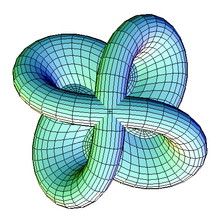In the mathematical field of topology, a regular homotopy refers to a special kind of homotopy between immersions of one manifold in another. The homotopy must be a 1-parameter family of immersions.
Similar to homotopy classes, one defines two immersions to be in the same regular homotopy class if there exists a regular homotopy between them. Regular homotopy for immersions is similar to isotopy of embeddings: they are both restricted types of homotopies. Stated another way, two continuous functions are homotopic if they represent points in the same path-components of the mapping space , given the compact-open topology. The space of immersions is the subspace of consisting of immersions, denoted by . Two immersions are regularly homotopic if they represent points in the same path-component of .
Examples
Any two knots in 3-space are equivalent by regular homotopy, though not by isotopy.

The Whitney–Graustein theorem classifies the regular homotopy classes of a circle into the plane; two immersions are regularly homotopic if and only if they have the same turning number – equivalently, total curvature; equivalently, if and only if their Gauss maps have the same degree/winding number.

Stephen Smale classified the regular homotopy classes of a k-sphere immersed in – they are classified by homotopy groups of Stiefel manifolds, which is a generalization of the Gauss map, with here k partial derivatives not vanishing. More precisely, the set of regular homotopy classes of embeddings of sphere in is in one-to-one correspondence with elements of group . In case we have . Since is path connected, and and due to Bott periodicity theorem we have and since then we have . Therefore all immersions of spheres and in euclidean spaces of one more dimension are regular homotopic. In particular, spheres embedded in admit eversion if . A corollary of his work is that there is only one regular homotopy class of a 2-sphere immersed in . In particular, this means that sphere eversions exist, i.e. one can turn the 2-sphere "inside-out".
Both of these examples consist of reducing regular homotopy to homotopy; this has subsequently been substantially generalized in the homotopy principle (or h-principle) approach.
Non-degenerate homotopy
For locally convex, closed space curves, one can also define non-degenerate homotopy. Here, the 1-parameter family of immersions must be non-degenerate (i.e. the curvature may never vanish). There are 2 distinct non-degenerate homotopy classes. Further restrictions of non-vanishing torsion lead to 4 distinct equivalence classes.
See also
References
- Feldman, E. A. (1968). "Deformations of closed space curves". Journal of Differential Geometry. 2 (1): 67–75. doi:10.4310/jdg/1214501138.
- Little, John A. (1971). "Third order nondegenerate homotopies of space curves". Journal of Differential Geometry. 5 (3): 503–515. doi:10.4310/jdg/1214430012.
- Whitney, Hassler (1937). "On regular closed curves in the plane". Compositio Mathematica. 4: 276–284.
- Smale, Stephen (February 1959). "A classification of immersions of the two-sphere" (PDF). Transactions of the American Mathematical Society. 90 (2): 281–290. doi:10.2307/1993205. JSTOR 1993205.
- Smale, Stephen (March 1959). "The classification of immersions of spheres in Euclidean spaces" (PDF). Annals of Mathematics. 69 (2): 327–344. doi:10.2307/1970186. JSTOR 1970186.
 are homotopic if they represent points in the same path-components of the mapping space
are homotopic if they represent points in the same path-components of the mapping space  , given the
, given the  . Two immersions
. Two immersions  – they are classified by
– they are classified by  of regular homotopy classes of embeddings of sphere
of regular homotopy classes of embeddings of sphere  in
in  . In case
. In case  we have
we have  . Since
. Since  is path connected,
is path connected,  and
and  and due to Bott periodicity theorem we have
and due to Bott periodicity theorem we have  and since
and since  then we have
then we have  . Therefore all immersions of spheres
. Therefore all immersions of spheres  and
and  in euclidean spaces of one more dimension are regular homotopic. In particular, spheres
in euclidean spaces of one more dimension are regular homotopic. In particular, spheres  embedded in
embedded in  admit eversion if
admit eversion if  . A corollary of his work is that there is only one regular homotopy class of a 2-sphere immersed in
. A corollary of his work is that there is only one regular homotopy class of a 2-sphere immersed in  . In particular, this means that
. In particular, this means that